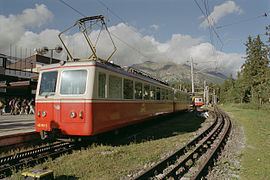 | ||
Jazda ozubnicovou eleznicou trbsk pleso trba
The Štrbské Pleso–Štrba rack railway is a 1,000 mm (3 ft 3 3⁄8 in) gauge narrow-gauge railway in the High Tatras. It was built in 1896 and reconstructed in 1970. At the valley terminus (Štrba railway station), it connects to the standard-gauge main line between Bratislava and Košice, and at the mountain terminus (Štrbské Pleso railway station), it connects to the Tatra Electric Railway.
Contents
History
With the completion of the Košice–Bohumín Railway in 1871, the High Tatras received their first railway connection. Tourism to Štrbské pleso arising from this led to the opening of hotels, footpaths and mountain huts.
Under the management of Emil Várnai, the Košice–Bohumín Railway developed plans for a metre-gauge rack railway connecting Štrbské pleso to the station at Štrba. On 30 July 1895 the railway received a concession from the Hungarian Trade Ministry. Building began quickly and the railway opened on 30 July 1896. The Košice–Bohumín Railway founded the Csorbatói Fogaskerekű Vasút (Slovak: Ozubnicová železnica Štrbského plesa, English: Štrbské Pleso Rack Railway) to operate the railway. The line was only operated during the summer season between June and September and in winter for the ski season. For more than six months of the year there was no traffic.
From the 1920s there was strong competition from motor transport and the railway was no longer profitable. In 1924 the railway (together with the Košice–Bohumín Railway) was taken over by the Czechoslovak State Railways. The Tatranská elektrická vicinálna dráha (TEVD) was founded in 1927 to operate the Tatra Electric Railway but refused to take over the old and inefficient rack railway.
During the Great Depression traffic on the rack railway was ended on 14 September 1932. On 11 December 1936 the concession to operate the railway ended and in the 1940s the line was dismantled.
Technical data
Rolling stock
In 1896 two steam locomotives were delivered from the Floridsdorf Locomotive Factory, Austria, with manufacturer's numbers 1012 and 1013. Four identical locomotives, which are still in service, were later built for the Achenseebahn. The locomotives were originally numbered 1 and 2 but were renumbered by ČSD as U 29.001 and U 29.002. There were also four passenger carriages and four goods wagons which were built by Ganz in Budapest.
History
In 1968, in connection with the FIS Nordic World Ski Championships 1970 in Štrbské Pleso, plans were made for a new rack railway. Two-thirds of the old route was used but the rest was of the route was entirely new. In Štrbské Pleso a new joint railway station with the Tatra Electric Railway was laid out, with a track connection for transferring vehicles. At Štrba railway station a new departure hall for the rack railway was built. The new railway was electrified at 1500 V DC, the same system as that used for the Tatra Electric Railway. The new railway was opened on 12 February 1970.
Technical data
Rolling stock
Three new trains were delivered from Swiss Locomotive and Machine Works for the rebuilt line. The trains consist of a driving trailer of ČSD class R 29.0 (now ZSSK class 905.95) and a rack railcar of ČSD class EM 29.0 (now ZSSK class 405.95).
